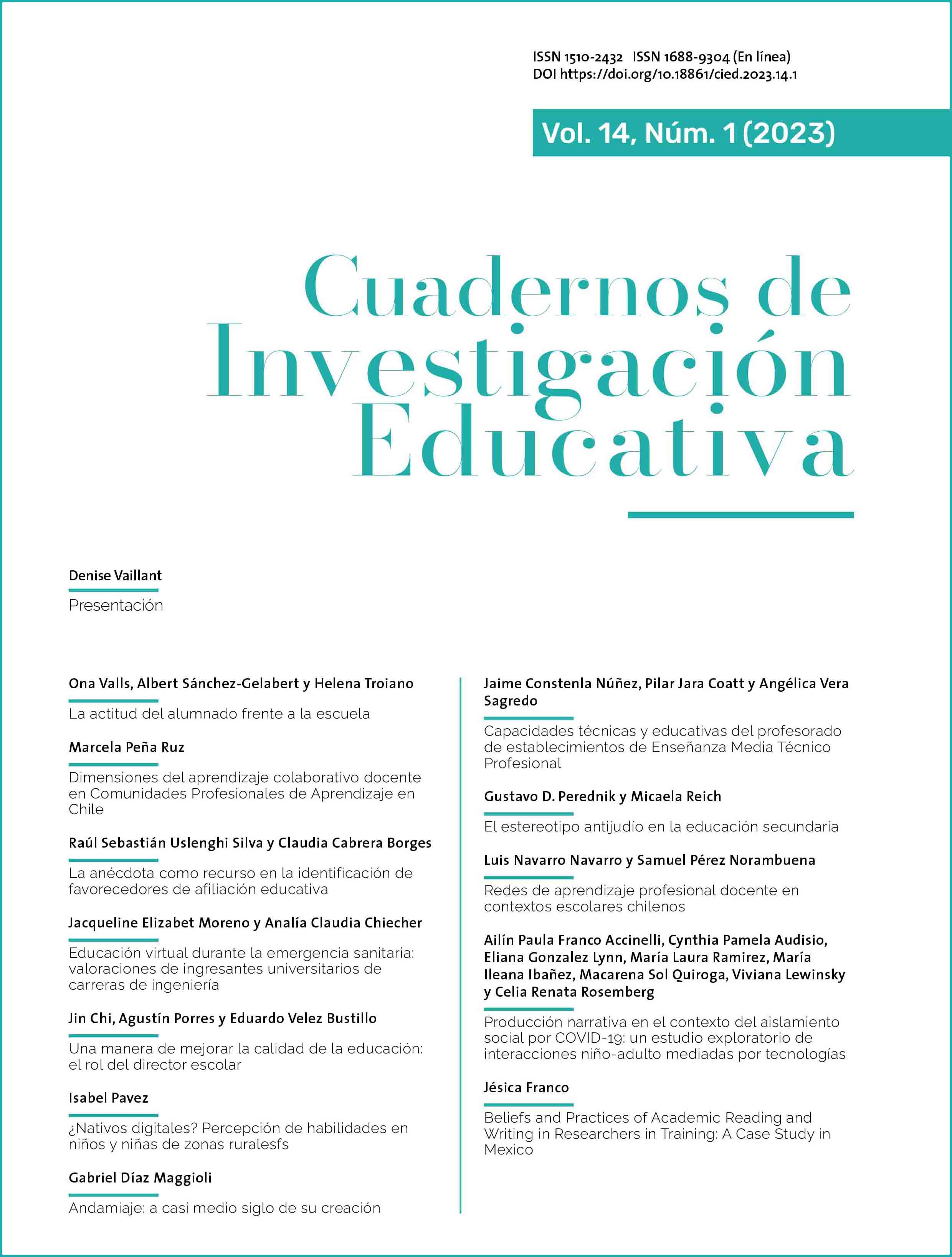Andamiaje: a casi medio siglo de su creación
DOI:
https://doi.org/10.18861/cied.2023.14.1.3251Palabras clave:
mediación, andamiaje, Zona de Desarrollo Próximo, perspectiva sociocultural, metaanálisis, enseñanza, aprendizajeResumen
La metáfora del andamiaje fue acuñada en la segunda mitad del siglo XX para dar cuenta de una forma específica de mediación de los aprendizajes. Desde su inicio en el campo educativo, ha evolucionado y se la ha utilizado para hacer referencia a una amplia variedad de constructos relacionados con la enseñanza y el aprendizaje. Debido a la polisemia resultante de esta situación, se decidió realizar un metaanálisis de la literatura sobre andamiaje desde su incepción hasta tiempos recientes. Dicho metaanálisis confirmó la existencia de diferentes conceptualizaciones de la metáfora y evidenció la necesidad de abogar por un posicionamiento epistemológico específico en el campo de la enseñanza y el aprendizaje.
Descargas
Citas
Bickhard, M. (2005). Functional scaffolding and self-scaffolding. New Ideas in Psychology, 23, 166-173.
Bliss, J., Askew, M., & Macrae, S. (1996). Effective teaching and learning: Scaffolding revisited. Oxford Review of Education, 22(1), 37-61.
Botella, J. & Zamora, A. (2017). El metaanálisis: una metodología para la investigación en educación. Educación XXI 20(2), 17-38. https://doi.org/10.5944/educxx1.19030
Bruner, J., & Sherwoord, V. (1976). Peekaboo and the learning of rule structures. In J. Bruner, A. Jolly, & K. Sylva (Eds.), Play: Its role in development and evolution (pp. 277-287). Penguin Books.
Chaiklin, S. (2003). The Zone of Proximal Development in Vygotsky’s analysis of learning and instruction. In A. Kozulin, B. Gindis, V. Ageyev, & S. M. Miller (Eds.), Vygotsky’s educational theory in cultural context (pp. 39-64). Cambridge University Press.
Díaz Maggioli, G. (2013). Of metaphors and literalization: Reconceptualizing scaffolding in language teaching. Encounters/Encuentros/Rencontres on Education 14, pp. 133-150.
Díaz Maggioli, G. (2022). Initial Language Teacher Education. Routledge.
Feuerstein, R., Rand, Y., Hoffman, M., & Miller, R. (1980). Instrumental enrichment: An intervention program for cognitive modifiability. University Park Press.
Gibbons, P. (2002). Scaffolding language, scaffolding learning: Teaching Second Language Learners in the mainstream classroom. Heinemann.
Gibbons, P. (2003). Mediating language learning: Teacher interactions with ESL students in content-based classrooms. TESOL Quarterly, 37(2), 247-273.
Glass, G. V., McGraw, B., & Smith, M. L. (1981). Meta-analysis of social research. Sage.
Guba, E. G., & Lincoln, Y. S. (1994). Competing paradigms in qualitative research. In Denzin, N.K. & Lincoln, Y.S. (Eds.), Handbook of qualitative research (pp. 105 - 117). Sage Publications, Inc.
Hammond, J., & Gibbons, P. (2005). Putting scaffolding to work: The contribution of scaffolding in articulating ESL education. Prospect, 20(1), 6-30.
Holton, D., & Clarke, D. (2006). Scaffolding and metacognition. International Journal of Mathematical Education in Science and Technology, 37(2), 127-143.
Johnson, K. E. (2009). Second language teacher education: A sociocultural perspective. Routledge.
Kozulin, A. (1998). Psychological tools: A sociocultural approach to education. Harvard University Press.
León Hernández, S. R., & Aguilera Zepeda, J. M. (2001). Metodología de los estudios de metaanálisis en la investigación clínica. Revista Mexicana de Ortopedia Traumática, 15(2), 86-91.
Littleton, K. & Mercer, N. (2013). Interthinking: Putting talk to work. Routledge.
Mason, J., 2002. Researching your own practice: The discipline of noticing. Routledge.
Mercer, N. & Howe, C. (2012). Explaining the dialogic processes of teaching and learning: The value and potential of Sociocultural theory. Learning, Culture and Social Interaction, 1(1), 12-21.
Mercer, N. (2000). Words & Minds: How we use language to think together. Routledge.
Mercer, N. (2004). Sociocultural discourse analysis: Analysing talk as a social mode of thinking. Journal of Applied Linguistics, 1(2), 137-168.
Poehner, M. E. (2010). Dynamic assessment: A Vygotskian approach to understanding and promoting L2 development. Springer.
Poehner, M. E., & Lantolf, J. P. (2005). Dynamic assessment in the language classroom. Language Teaching Research, 9(3), 233-265.
Saldaña, J. (2013). The coding manual for qualitative researchers. Sage.
Sharpe, T. (2006). “Unpacking” scaffolding: Identifying discourse and multimodal strategies that support learning. Language and Education, 20(3), 211-231.
Sherin, B., Reiser, J., & Edelson, D. (2009). Scaffolding analysis: Extending the scaffolding metaphor to learning artifacts. Journal of the Learning Sciences, 13(3), 387-421.
Shrum, J. L., & Glisan, E. W. (2010). Teacher’s Handbook: Contextualized Language Instruction. Cengage Learning.
Swain, M., Kinnear, P., & Steinman, L. (2011). Sociocultural theory in second language education: An introduction through narratives. Multilingual Matters.
Vaillant, D. & Marcelo, C. (2021). Formación inicial del profesorado: Modelo actual y llaves para el cambio. REICE. Revista Iberoamericana sobre Calidad, Eficacia y Cambio en Educación, 19(4), 55-69. https://doi.org/10.15366/reice2021.19.4.003
Vélez-Ibáñez, C. G., & Greenberg, J. B. (1992). Formation and transformation of funds of knowledge. Anthropology and Education Quarterly, 23, 313-335.
Verenikina, I. (2004). From theory to practice: What does the metaphor of scaffolding mean to educators today? Outlines, 2, 5-15.
Viada González, C., Fors López, M., Ballesteros, J., Álvarez Cardona, M., Frías Blanco, A. & García Fernández, L. (2018). Metodología y sistemas para el metaanálisis de ensayos clínicos. Revista Cubana de Informática Medica, 10(2). http://www.revinformatica.sld.cu/index.php/rcim/article/view/306
Vygotsky, L. S. (1978). Mind in society: The development of higher psychological processes. Harvard University Press.
Vygotsky, L. S. (1987). The collected works of Lev S. Vygotsky. Volume I: Problems of General Psychology. Plenum Press.
Walqui, A. (2006). Scaffolding instruction for English Language Learners: A conceptual framework. International Journal of Bilingual Education and Bilingualism, 9(2), 159-180.
Walqui, A., & van Lier, L. (2010). Scaffolding the academic success of adolescent English Language Learners. WestEd.
Wood, D., Bruner, J., & Ross, G. (1976). The role of tutoring in problem solving. Journal of Child Psychology and Psychiatry, 17, 89-100.






